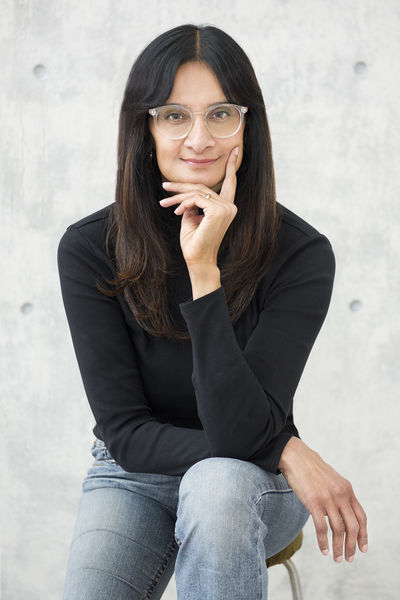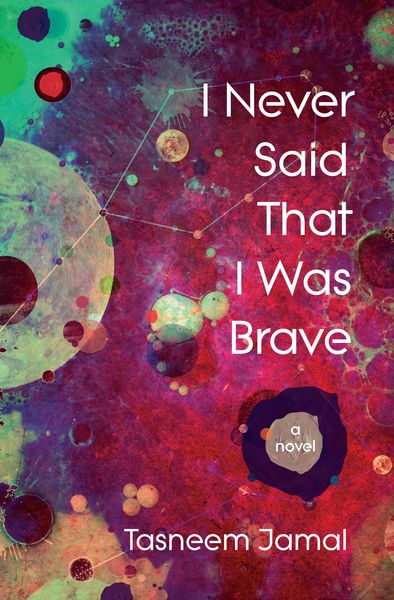Tasneem Jamal Delivers a Powerful Story About Female Friendship and Betrayal with I Never Said That I Was Brave
Acclaimed author Tasneem Jamal has already made a distinct impression in the literary world with her debut novel Where the Air Is Sweet, and by the writing she has published in numerous magazines and journals. And, this fall, she returns with a fascinating, tension-filled story of female friendship and betrayal.
In I Never Said That I Was Brave (House of Anansi Press), we follow an unnamed narrator over the course of 40 years, and the complicated relationship between two women who experience the shifting dynamics of a friendship fraught with guilt and confusion, and forever affected by their immigration to Canada from Uganda as children. The narrator delves into her memories of the past, and the unpredictable and unreliable paths that she and her friend Miriam - an astrophysicist who studies dark matter - have taken in their lives.
It is a devastating novel that blurs lines and challenges the reader's instincts and sense of right and wrong, always told in rich, skillful prose.We're delighted to share this Long Story Novelist interview with the author today, and to learn more about the ingredients that went into this breathtaking new work.
Open Book:
Do you remember how your first started this novel or the very first bit of writing you did for it?
Tasneem Jamal:
My answer will be somewhat convoluted because this book was different from other projects I’ve done in that I didn’t set out to do it. This isn’t to say I didn’t wish to write a novel. On the contrary, I really—almost painfully—wanted to write and publish a second novel. But this focus on the outcome was killing my creativity. In 2018 my friends, the writers Carrie Snyder and Emily Urquhart, and I started a writing group, which met every two weeks. The purpose was to do some peer mentoring but also to give us time and space to focus exclusively on our creativity. We are, like so many other women, busy with raising children, caring for elderly parents, trying to earn money. But, in addition, we are creative writers. The writing part of our lives can easily become lost. We realized it would be helpful to support each other with regular meetings rather than the odd dinner or meet-up at a festival. During our writing group, we often do Lynda Barry’s X Page exercises. This process is fascinating in that it gently takes you out of any intellectual effort; instead, it magically taps into the creative, play-like part of the brain. Carrie and Emily were very good about reminding me to stay in this state and trust that it’s enough. (I was inclined, as I mentioned, to push for a final publish-worthy book product.) I noticed after a year or so that the scenes I was writing had recurring characters and settings and an overall feel. I worked with these, played around with some longtime personal obsessions (namely: quantum physics and infidelity) and a book took shape. The whole process took about four years, from the first scenes written in 2018 to a completed manuscript in 2022.
OB:
How did you choose the setting of your novel? What connection, if any, did you have to the setting when you began writing?
TJ:
As I wrote those scenes, which I mentioned in the previous answer, the images that continually appeared were from the landscape of my childhood in Kitchener, Ontario, in the 1970s and 1980s. It wasn’t only the physical spaces that appeared to me; I heard the music of the time, felt myself as a child wearing the shoes I had worn, daydreaming as I had once daydreamed as I played in the local park. The book—the process of writing the book, rather—was grounded in that time and place. I wrote the scenes while living in Kitchener and would at times drive through some of the old neighborhoods I mention in the novel, some of which haven’t changed all that much. But this sightseeing was more of a fun thing to do. It wasn’t research. My imagination was creating the setting.
OB:
If you had to describe your book in one sentence, what would you say?
TJ:
Using concepts from quantum physics as a metaphorical backdrop, an unreliable narrator stuck in the margins of her own life tells us about how she betrayed her oldest friend.
Your CanLit News
Subscribe to Open Book’s newsletter to get local book events, literary content, writing tips, and more in your inbox
OB:
Did you do any specific research for this novel? Tell us a bit about that process.
TJ:
I researched the science because it underpins much of the book. In fact, the working title of the novel was “The Uncertainty Principle.” For many years, I have had an interest in quantum physics, from a metaphorical rather than mathematical perspective (math has always been a challenge for me). I knew I wanted to play around with some quantum physics concepts in the novel, but I needed to ensure that I had an accurate handle of the science. I read a few physics books for non-scientists (for example, I read Astrophysics for People in a Hurry by Neil de Grasse Tyson). I listened to podcasts on astrophysics, again ones directed at non-experts. And I watched many, many YouTube videos. The Perimeter Institute of Theoretical Physics (incidentally located near me in Waterloo) has some great videos that break down complex concepts. I thoroughly enjoyed this research and often had to pull myself away. I will add, however, that this science does not come easily or naturally to me. I had to keep reviewing it because it slips so easily from my mind. For this reason, I asked two astrophysics to review the science within the novel before publication.
OB:
Who did you dedicate your novel to, and why?
TJ:
I dedicated the novel to my daughters: For Mia and Lily, who used to dwell among the stars and were summoned to the earth for me.
The book focuses on women, and in particular the impact mothers have on daughters. It was natural to dedicate it to my own daughters. As for the words in the dedication, they are teenagers now, but when they were small, I had a playlist of bedtime songs I’d put on while we lay in bed and talked. Our conversations were usually light-hearted but sometimes they were philosophical. One night Mia—she was probably five or six—asked where she had been before she was born. One of our bedtime songs—a Hindi film song—features a lover telling his beloved that he is on earth for her, that he used to dwell among the stars until he was summoned for her. I translated it for the girls and said this is true of them with respect to me and their father. I thought it was a sweet answer to a big question. And they seemed to like this idea. Recently, however, Mia told me she had taken this quite literally; and in her childhood she would imagine herself floating among the stars. So, within our family we’ve accepted this beautiful story— woven from poetry, fantasy and truth—of their origins.
OB:
Did you include an epigraph in your book? If so, how did you choose it and how does it relate to the narrative?
TJ:
This is an interesting question. I did in fact have an epigraph in my book right up until the ARC. We removed it before publication because obtaining copyright was proving complex. I quoted a line from a Hindi film song about how it is wrong for the weak of heart to fall in love—and yet today we will hear about such a heart falling in love. I felt the novel’s narrator could have uttered these words herself to open the story. In addition, Hindi films and songs feature within the novel for a reason. The narrator is telling a story, at times a melodramatic Bollywood-like tale wherein reality and her romantic and tragic ideas of it are blurred.
Ultimately the book stands on its own and I was absolutely content not to include the epigraph.
OB:
What if, anything, did you learn from writing this novel?
TJ:
I learned to trust that the process of writing it is enough. Whenever I did this, the scene, the story, the novel, came to me. I didn’t have to fight for it.
__________________________________________
Tasneem Jamal was born in Mbarara, Uganda, and immigrated to Canada in 1975. Her debut novel Where the Air Is Sweet was published to critical acclaim in 2014. That same year she was named one of 12 rising CanLit stars on CBC's annual list of Writers to Watch. Her writing has appeared in Chatelaine, Saturday Night magazine, and the Literary Review of Canada. She is the writing coach of The X Page Storytelling Workshop and an editor at The New Quarterly literary magazine. She lives in Kitchener.






